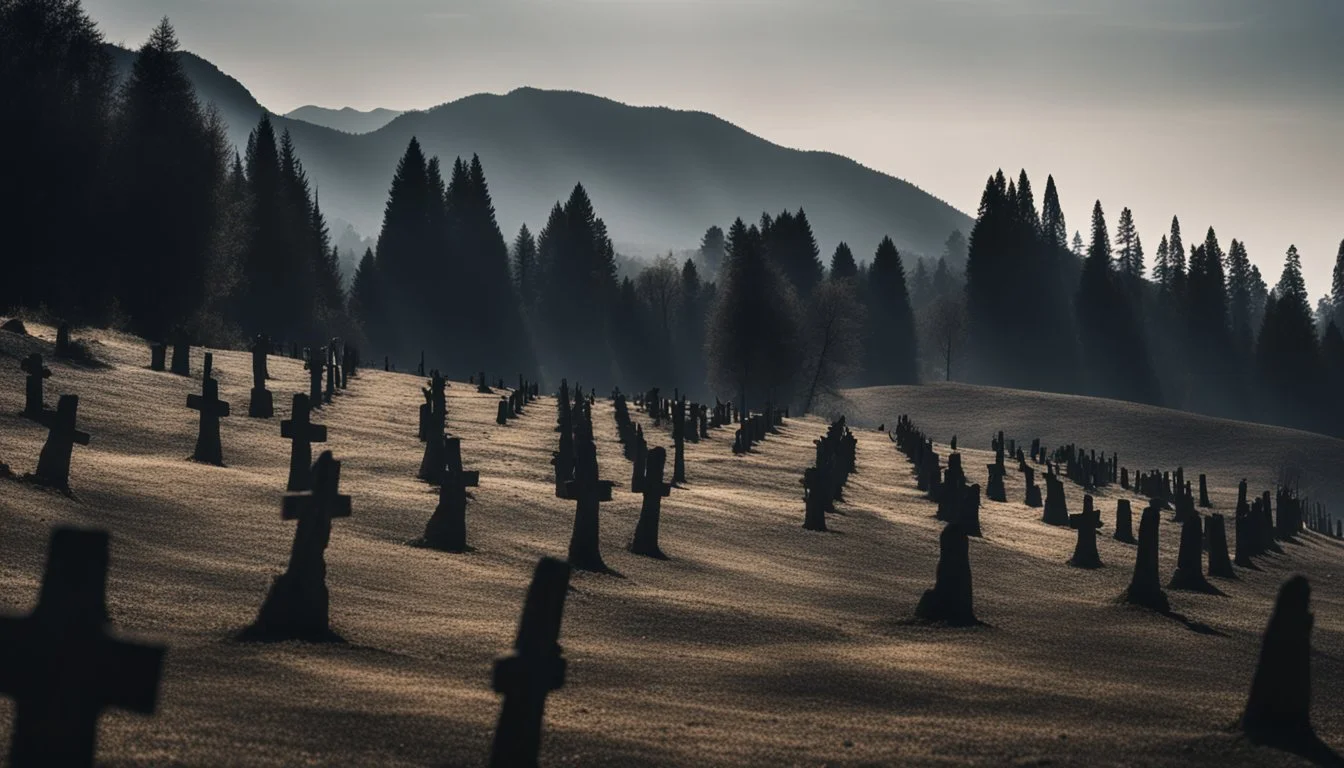Joshua Oppenheimer: Confronting the Ghosts of Genocide in Film and History
Joshua Oppenheimer has established himself as a pivotal figure in documentary filmmaking, particularly through his works that confront some of the darkest episodes in human history. His films "The Act of Killing" and "The Look of Silence" delve deep into the Indonesian genocide of 1965, offering a platform for both the victims and the perpetrators to share their stories. Oppenheimer's unique approach forces viewers to confront the lingering legacy of mass violence and the chilling ease with which societies can slip into such atrocities.
In "The Act of Killing," Oppenheimer challenges former death squad members to reenact their crimes in any cinematic style they choose, resulting in a disturbing yet insightful look at their psyche. "The Look of Silence" shifts focus to the victims, particularly Adi Rukun, who bravely confronts his brother's murderers under the pretense of an eye examination. These powerful narratives not only shed light on the human cost of political violence but also expose the deep wounds that persist in communities long after the events have passed.
Oppenheimer's work goes beyond mere documentation; it facilitates a necessary dialogue about memory, justice, and reconciliation. By revealing the personal stories behind historical statistics, his films ensure that the ghosts of genocide are neither forgotten nor ignored.
Joshua Oppenheimer: The Filmmaker's Journey
Joshua Oppenheimer is a talented documentarian known for his intense and revealing films on genocide. His journey from early life through his motivating influences unveils the path that led him to create powerful works such as "The Act of Killing" and "The Look of Silence."
Early Life and Education
Born in 1974 in the United States, Joshua Oppenheimer showed an early interest in storytelling and film. He later pursued this passion academically, studying filmmaking and earning degrees from institutions known for their rigorous arts programs.
Oppenheimer's education included both practical and theoretical components, providing a strong foundation for his later work. It was during these formative years that he began to develop his unique voice and approach to documentary filmmaking.
Influences and Motivations
Oppenheimer's work is deeply influenced by his exposure to global conflicts and the human rights abuses that arise from them. The Indonesian genocide of 1965-1966 became a central focus, driven by his compassionate desire to bring hidden atrocities to light.
Oppenheimer's collaborations with influential documentarians like Werner Herzog and Errol Morris have also shaped his style and methodology. His films not only document but challenge viewers to confront the moral and ethical implications of violence and memory.
This blend of personal drive and collaborative influence defines Oppenheimer's cinematic journey, resulting in groundbreaking documentaries that resonate with audiences worldwide.
The Act of Killing: Unmasking Perpetrators
Joshua Oppenheimer's The Act of Killing brings to light the unsettling actions of individuals involved in the Indonesian mass killings of 1965-66. The film is a deep dive into the psyche of these perpetrators and the societal backdrop that allowed such atrocities to occur.
Film's Synopsis
The Act of Killing is an experimental documentary directed by Joshua Oppenheimer, Christine Cynn, and an anonymous Indonesian co-director. The film unveils the brutal reality of the Indonesian genocide by focusing on the perpetrators. It follows former death squad leaders who re-enact their real-life atrocities in various cinematic genres, from Westerns to musicals. This approach reveals a disturbing blend of boastfulness and guilt, highlighting their desensitization to violence.
Production Challenges
Producing The Act of Killing took over seven years, reflecting the complexity and danger involved. Oppenheimer and his team had to navigate a treacherous political landscape and ensure the safety of all participants. The involvement of an anonymous co-director underscores the risks faced by those exposing human rights abuses in Indonesia. Filming required a delicate balance between gaining the trust of perpetrators and protecting the identities of vulnerable sources.
Critical Reception and Impact
Critically acclaimed, The Act of Killing has been hailed as a groundbreaking work in documentary filmmaking. It received numerous awards, including the BAFTA for Best Documentary and an Academy Award nomination. The film’s innovative approach and its unsettling portrayal of unrepentant killers have sparked global conversations about memory, justice, and reconciliation. It has also influenced other filmmakers and raised awareness about the Indonesian genocide, prompting calls for historical accountability and justice.
The Look of Silence: A Companion Piece
The Look of Silence, directed by Joshua Oppenheimer, serves as a powerful extension to his previous work, The Act of Killing. This film shifts the narrative focus from the perpetrators of the 1965 Indonesian genocide to the survivors, providing a deeply personal and harrowing look at their experiences and ongoing quest for justice.
Comparative Analysis with The Act of Killing
While The Act of Killing scrutinized the killers and their chilling reenactments of violence, The Look of Silence centers on Adi, an optometrist and genocide survivor. The stark difference in narrative approach allows viewers to see the lasting impact of atrocities from the victims' perspective.
The contrast in cinematography is notable. The Act of Killing employs surreal imagery, while The Look of Silence features intimate, raw interviews.
Both films highlight the theme of impunity within Indonesian society, but The Look of Silence underscores the emotional scars left on the victims' families. This thematic shift provides a complementary yet distinct understanding of the genocide's aftermath.
Survivors' Perspectives
The film follows Adi's courageous quest to confront the men responsible for his brother's murder. These poignant encounters reveal the profound trauma carried by survivors. Through Adi's interactions, the audience gains insight into the psychological and emotional toll faced by families affected by the genocide.
Interviews with perpetrators juxtaposed with Adi's quiet determination highlight the pervasive fear and unresolved grief within the survivor community. This personal narrative underscores the broader struggle for recognition and justice that extends beyond individual pain.
Oppenheimer's decision to focus on the survivors’ stories rather than the perpetrators establishes a more emotionally resonant narrative. This shift enhances the audience’s connection to the real-life consequences of historical atrocities.
Global Response
The Look of Silence has garnered international acclaim, receiving an Oscar® nomination and numerous awards. The film's impact extended beyond cinematic circles, sparking discussions on human rights and the need for reconciliation in Indonesia.
Human rights organizations and activists praised the film for shedding light on a largely unacknowledged chapter of history. The global response emphasized the importance of addressing past atrocities to foster healing and prevent future violations.
The film also inspired academic discourse, with scholars analyzing its contribution to documentary filmmaking and its role in historical memory. The Look of Silence continues to resonate globally, emphasizing the need for truth and accountability in addressing historical injustices.
Methodology in Documentary Filmmaking
Joshua Oppenheimer employs distinct methods in his documentaries, focusing on ethical storytelling and innovative techniques. These approaches allow him to confront sensitive topics like genocide with depth and responsibility.
Ethics and Storytelling
Oppenheimer prioritizes ethical considerations in his storytelling. His approach involves gaining the trust of his subjects, especially when tackling traumatic events like the Indonesian genocide. By allowing perpetrators and victims to share their stories, he ensures multiple perspectives are represented.
Transparency is crucial. Oppenheimer clearly communicates his intentions and the nature of the documentary to all participants. This builds a foundation of trust and honesty. He also practices informed consent, ensuring that participants fully understand their involvement.
Another critical aspect is respect for the subject matter. Oppenheimer avoids sensationalism, focusing instead on respectful yet honest portrayals of his subjects' experiences. This ethical approach helps maintain the integrity of the documentary while fostering a deeper understanding among viewers.
Innovative Techniques
Oppenheimer uses innovative techniques to enhance the impact of his documentaries. One notable method is reenactments. In "The Act of Killing," perpetrators reenact their crimes, providing a surreal and disturbing insight into their mindset. This approach blurs the line between reality and performance, adding a unique layer of complexity.
He also employs metafilmic elements, where the filmmaking process itself becomes part of the narrative. This technique raises questions about representation, memory, and the role of the documentarian.
Visuals and symbolic imagery are used extensively. Creative use of visuals can evoke strong emotional responses and highlight thematic elements. In "The Look of Silence," for example, close-up shots of Adi’s eyes as he confronts his brother's killers serve as a powerful motif.
These innovative techniques help Oppenheimer create compelling, thought-provoking documentaries that challenge traditional narrative forms and engage viewers on multiple levels.
Themes and Motifs
Joshua Oppenheimer's works explore the aftermath of the 1965 Indonesian genocide, delving into both the survivors' and perpetrators' perspectives. Key themes include confronting past atrocities, seeking justice and reconciliation, and grappling with memory and forgiveness.
Confronting the Past
The act of confronting past atrocities lies at the heart of Oppenheimer's documentaries. He showcases survivors who must face the reality of their loved ones' deaths. Adi Rukun in The Look of Silence confronts his brother's killers, seeking answers that were buried for decades.
Oppenheimer's films highlight the courage needed to face such horrors. By documenting these confrontations, viewers witness the emotional toll on both survivors and perpetrators. This theme challenges audiences to reflect on historical accountability and the personal bravery required to confront painful pasts.
Justice and Reconciliation
Justice and reconciliation are central to Oppenheimer's exploration of the Indonesian genocide. The films emphasize the absence of legal justice for the atrocities committed. Perpetrators remain free, often holding positions of power.
Despite this, Oppenheimer depicts the survivors' attempts to seek their own forms of justice. Emotional confrontations in The Look of Silence serve as symbolic acts of justice, giving voice to the silent memories of victims. The theme also shows the complexity of reconciliation, portraying difficult paths towards societal healing.
Memory and Forgiveness
Oppenheimer's focus on memory and forgiveness reveals the long-lasting impact of trauma. His films capture survivors' struggles with unresolved grief and the perpetrators' denial or justification of their actions. The haunting memories of the genocide are visualized through intimate interviews and powerful imagery.
Forgiveness is portrayed as a difficult journey, not easily granted or achieved. By showing the survivors' enduring pain and the perpetrators' lack of remorse, the narratives underscore the intricate processes behind forgiveness. This nuanced portrayal invites viewers to consider the depth of emotional scars left by historical violence.
Impact on Society and Culture
Joshua Oppenheimer's works have significantly shaped both the cinematic landscape and educational discussions about historical atrocities. His innovative approach to documentary filmmaking and his focus on uncovering truths have left a lasting impression.
Influence on Cinema
Oppenheimer's "The Act of Killing" and "The Look of Silence" introduced groundbreaking narrative techniques in documentary filmmaking. These films are notable for their unique blend of re-enactments and interviews with perpetrators of violence. By allowing these individuals to dramatize their own actions, Oppenheimer exposed the depths of human cruelty in ways that traditional documentaries had not attempted.
This method not only captivated audiences but also inspired filmmakers to explore new storytelling methods. Moreover, his work has been recognized with numerous awards, including the European Film Award for Best Documentary and an Oscar nomination. Oppenheimer's contributions have paved the way for a more immersive and reflective genre of documentary cinema.
Educational Relevance
In educational contexts, Oppenheimer's films serve as crucial tools for understanding the complexities of genocide and the psychological factors behind mass violence. Academic institutions frequently use "The Act of Killing" and "The Look of Silence" in courses on history, political science, and human rights.
These documentaries offer valuable insights into the Indonesian genocide, providing personal accounts and showcasing the lasting impact of historical trauma on societies. Oppenheimer's approach encourages critical thinking and discussions around ethics, memory, and the importance of confronting uncomfortable truths. By incorporating these films into their curricula, educators can foster a more nuanced and empathetic understanding of past atrocities.
Critiques and Controversies
Joshua Oppenheimer's films have sparked significant discussions on ethical concerns and have elicited varied reactions from Indonesian society. This section examines the ethical debates around his filmmaking methods and the responses from Indonesia.
Ethical Debates
The use of reenactments in The Act of Killing raised ethical questions. Critics argued that asking perpetrators to reenact their crimes risked perpetuating trauma among survivors and glamorizing violence.
Oppenheimer defended his approach, stating it aimed to reveal the psychological and social mechanisms behind the genocide. Nonetheless, the ethical implications of giving a platform to those who committed atrocities remain contentious.
Responses from Indonesia
In Indonesia, The Act of Killing was met with a spectrum of reactions. Some praised the film for shedding light on a dark chapter of history that many preferred to forget.
However, others criticized it for potentially defaming the nation and its people. Government officials and nationalist groups expressed discomfort, fearing the film undermined Indonesia's image on the global stage.
Thus, while Oppenheimer’s work is celebrated internationally, it continues to provoke mixed feelings within Indonesia.






